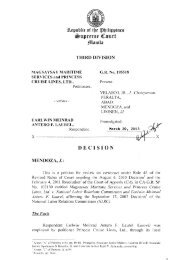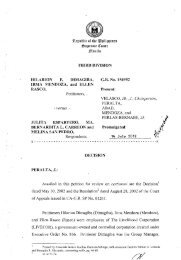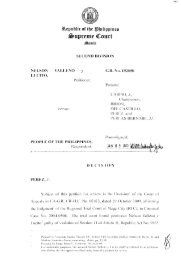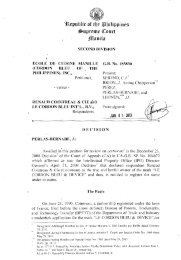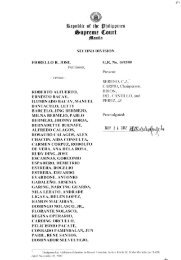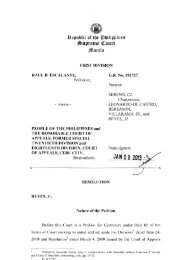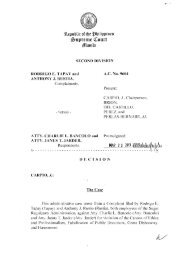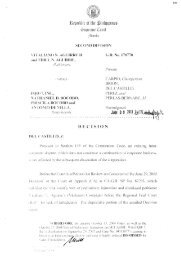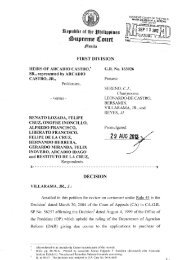G.R. No. 189871, August 13, 2013. - Supreme Court of the Philippines
G.R. No. 189871, August 13, 2013. - Supreme Court of the Philippines
G.R. No. 189871, August 13, 2013. - Supreme Court of the Philippines
Create successful ePaper yourself
Turn your PDF publications into a flip-book with our unique Google optimized e-Paper software.
Decision - 3 - G.R. <strong>No</strong>. <strong>189871</strong>WHEREFORE, premises considered, judgment is hereby renderedfinding respondents guilty <strong>of</strong> constructive dismissal and are <strong>the</strong>refore,ordered:1. To pay jointly and severally <strong>the</strong> complainant <strong>the</strong> amount <strong>of</strong>sixty-two thousand nine hundred eighty-six pesos and 56/100(P62,986.56) Pesos representing his separation pay;2. To pay jointly and severally <strong>the</strong> complainant <strong>the</strong> amount <strong>of</strong>nine (sic) five thousand nine hundred thirty-three and 36/100(P95,933.36) representing his backwages; and3. All o<strong>the</strong>r claims are hereby dismissed for lack <strong>of</strong> merit.SO ORDERED. 4Respondents appealed to <strong>the</strong> NLRC, but it was dismissed for lack <strong>of</strong>merit in <strong>the</strong> Resolution 5 dated February 29, 2000. Accordingly, <strong>the</strong> NLRCsustained <strong>the</strong> decision <strong>of</strong> <strong>the</strong> Labor Arbiter. Respondents filed a motion forreconsideration, but it was denied. 6Dissatisfied, respondents filed a Petition for Review on Certioraribefore <strong>the</strong> CA. On <strong>August</strong> 24, 2000, <strong>the</strong> CA issued a Resolution dismissing<strong>the</strong> petition. Respondents filed a Motion for Reconsideration, but it waslikewise denied in a Resolution dated May 8, 2001. 7Respondents <strong>the</strong>n sought relief before <strong>the</strong> <strong>Supreme</strong> <strong>Court</strong>, docketed asG.R. <strong>No</strong>. 15<strong>13</strong>32. Finding no reversible error on <strong>the</strong> part <strong>of</strong> <strong>the</strong> CA, this<strong>Court</strong> denied <strong>the</strong> petition in <strong>the</strong> Resolution dated April 17, 2002. 8An Entry <strong>of</strong> Judgment was later issued certifying that <strong>the</strong> resolutionbecame final and executory on May 27, 2002. 9 The case was, <strong>the</strong>reafter,referred back to <strong>the</strong> Labor Arbiter. A pre-execution conference wasconsequently scheduled, but respondents failed to appear. 10On <strong>No</strong>vember 5, 2002, petitioner filed a Motion for CorrectComputation, praying that his backwages be computed from <strong>the</strong> date <strong>of</strong> hisdismissal on January 24, 1997 up to <strong>the</strong> finality <strong>of</strong> <strong>the</strong> Resolution <strong>of</strong><strong>the</strong> <strong>Supreme</strong> <strong>Court</strong> on May 27, 2002. 11 Upon recomputation, <strong>the</strong>4567891011Id. at 82-84. (Emphasis supplied.)Id. at 85-93.Resolution dated July 24, 2000, id. at 94-96.Rollo, p. 35.Id. at 35-36.Id. at 36.Id. at 100.Id.
Decision - 4 - G.R. <strong>No</strong>. <strong>189871</strong>Computation and Examination Unit <strong>of</strong> <strong>the</strong> NLRC arrived at an updatedamount in <strong>the</strong> sum <strong>of</strong> P471,320.31. 12On December 2, 2002, a Writ <strong>of</strong> Execution <strong>13</strong> was issued by <strong>the</strong> LaborArbiter ordering <strong>the</strong> Sheriff to collect from respondents <strong>the</strong> total amount <strong>of</strong>P471,320.31. Respondents filed a Motion to Quash Writ <strong>of</strong> Execution,arguing, among o<strong>the</strong>r things, that since <strong>the</strong> Labor Arbiter awarded separationpay <strong>of</strong> P62,986.56 and limited backwages <strong>of</strong> P95,933.36, no morerecomputation is required to be made <strong>of</strong> <strong>the</strong> said awards. They claimed thatafter <strong>the</strong> decision becomes final and executory, <strong>the</strong> same cannot be altered oramended anymore. 14 On January <strong>13</strong>, 2003, <strong>the</strong> Labor Arbiter issued anOrder 15 denying <strong>the</strong> motion. Thus, an Alias Writ <strong>of</strong> Execution 16 was issuedon January 14, 2003.Respondents again appealed before <strong>the</strong> NLRC, which on June 30,2003 issued a Resolution 17 granting <strong>the</strong> appeal in favor <strong>of</strong> <strong>the</strong> respondentsand ordered <strong>the</strong> recomputation <strong>of</strong> <strong>the</strong> judgment award.On <strong>August</strong> 20, 2003, an Entry <strong>of</strong> Judgment was issued declaring <strong>the</strong>Resolution <strong>of</strong> <strong>the</strong> NLRC to be final and executory. Consequently, ano<strong>the</strong>rpre-execution conference was held, but respondents failed to appear on time.Meanwhile, petitioner moved that an Alias Writ <strong>of</strong> Execution be issued toenforce <strong>the</strong> earlier recomputed judgment award in <strong>the</strong> sum <strong>of</strong> P471,320.31. 18The records <strong>of</strong> <strong>the</strong> case were again forwarded to <strong>the</strong> Computation andExamination Unit for recomputation, where <strong>the</strong> judgment award <strong>of</strong>petitioner was reassessed to be in <strong>the</strong> total amount <strong>of</strong> only P147,560.19.Petitioner <strong>the</strong>n moved that a writ <strong>of</strong> execution be issued orderingrespondents to pay him <strong>the</strong> original amount as determined by <strong>the</strong> LaborArbiter in his Decision dated October 15, 1998, pending <strong>the</strong> finalcomputation <strong>of</strong> his backwages and separation pay.On January 14, 2003, <strong>the</strong> Labor Arbiter issued an Alias Writ <strong>of</strong>Execution to satisfy <strong>the</strong> judgment award that was due to petitioner in <strong>the</strong>amount <strong>of</strong> P147,560.19, which petitioner eventually received.12<strong>13</strong>1415161718Id. at 101.Id. at 97-102.Id. at 37.Id. at 103-108.Id. at 109-1<strong>13</strong>.Id. at 114-117.Id. at 101.
Decision - 5 - G.R. <strong>No</strong>. <strong>189871</strong>Petitioner <strong>the</strong>n filed a Manifestation and Motion praying for <strong>the</strong> recomputation<strong>of</strong> <strong>the</strong> monetary award to include <strong>the</strong> appropriate interests. 19On May 10, 2005, <strong>the</strong> Labor Arbiter issued an Order 20 granting <strong>the</strong>motion, but only up to <strong>the</strong> amount <strong>of</strong> P11,459.73. The Labor Arbiterreasoned that it is <strong>the</strong> October 15, 1998 Decision that should be enforcedconsidering that it was <strong>the</strong> one that became final and executory. However,<strong>the</strong> Labor Arbiter reasoned that since <strong>the</strong> decision states that <strong>the</strong> separationpay and backwages are computed only up to <strong>the</strong> promulgation <strong>of</strong> <strong>the</strong> saiddecision, it is <strong>the</strong> amount <strong>of</strong> P158,919.92 that should be executed. Thus,since petitioner already received P147,560.19, he is only entitled to <strong>the</strong>balance <strong>of</strong> P11,459.73.Petitioner <strong>the</strong>n appealed before <strong>the</strong> NLRC, 21 which appeal was deniedby <strong>the</strong> NLRC in its Resolution 22 dated September 27, 2006. Petitioner fileda Motion for Reconsideration, but it was likewise denied in <strong>the</strong> Resolution 23dated January 31, 2007.Aggrieved, petitioner <strong>the</strong>n sought recourse before <strong>the</strong> CA, docketed asCA-G.R. SP <strong>No</strong>. 98591.On September 23, 2008, <strong>the</strong> CA rendered a Decision 24 denying <strong>the</strong>petition. The CA opined that since petitioner no longer appealed <strong>the</strong> October15, 1998 Decision <strong>of</strong> <strong>the</strong> Labor Arbiter, which already became final andexecutory, a belated correction <strong>the</strong>re<strong>of</strong> is no longer allowed. The CA statedthat <strong>the</strong>re is nothing left to be done except to enforce <strong>the</strong> said judgment.Consequently, it can no longer be modified in any respect, except to correctclerical errors or mistakes.Petitioner filed a Motion for Reconsideration, but it was denied in <strong>the</strong>Resolution 25 dated October 9, 2009.Hence, <strong>the</strong> petition assigning <strong>the</strong> lone error:IWITH DUE RESPECT, THE HONORABLE COURT OF APPEALSSERIOUSLY ERRED, COMMITTED GRAVE ABUSE OF19202122232425Id. at 40.Id. at 65-69.Id. at 70-74.Id. at 60-64.Id. at 58-59.Id. at 33-48.Id. at 32.
Decision - 6 - G.R. <strong>No</strong>. <strong>189871</strong>DISCRETION AND DECIDED CONTRARY TO LAW INUPHOLDING THE QUESTIONED RESOLUTIONS OF THE NLRCWHICH, IN TURN, SUSTAINED THE MAY 10, 2005 ORDER OFLABOR ARBITER MAGAT MAKING THE DISPOSITIVE PORTIONOF THE OCTOBER 15, 1998 DECISION OF LABOR ARBITERLUSTRIA SUBSERVIENT TO AN OPINION EXPRESSED IN THEBODY OF THE SAME DECISION. 26Petitioner argues that notwithstanding <strong>the</strong> fact that <strong>the</strong>re was acomputation <strong>of</strong> backwages in <strong>the</strong> Labor Arbiter’s decision, <strong>the</strong> same is notfinal until reinstatement is made or until finality <strong>of</strong> <strong>the</strong> decision, in case <strong>of</strong> anaward <strong>of</strong> separation pay. Petitioner maintains that considering that <strong>the</strong>October 15, 1998 decision <strong>of</strong> <strong>the</strong> Labor Arbiter did not become final andexecutory until <strong>the</strong> April 17, 2002 Resolution <strong>of</strong> <strong>the</strong> <strong>Supreme</strong> <strong>Court</strong> in G.R.<strong>No</strong>. 15<strong>13</strong>32 was entered in <strong>the</strong> Book <strong>of</strong> Entries on May 27, 2002, <strong>the</strong>reckoning point for <strong>the</strong> computation <strong>of</strong> <strong>the</strong> backwages and separation payshould be on May 27, 2002 and not when <strong>the</strong> decision <strong>of</strong> <strong>the</strong> Labor Arbiterwas rendered on October 15, 1998. Fur<strong>the</strong>r, petitioner posits that he is alsoentitled to <strong>the</strong> payment <strong>of</strong> interest from <strong>the</strong> finality <strong>of</strong> <strong>the</strong> decision until fullpayment by <strong>the</strong> respondents.On <strong>the</strong>ir part, respondents assert that since only separation pay andlimited backwages were awarded to petitioner by <strong>the</strong> October 15, 1998decision <strong>of</strong> <strong>the</strong> Labor Arbiter, no more recomputation is required to be made<strong>of</strong> said awards. Respondents insist that since <strong>the</strong> decision clearly stated that<strong>the</strong> separation pay and backwages are “computed only up to [<strong>the</strong>]promulgation <strong>of</strong> this decision,” and considering that petitioner no longerappealed <strong>the</strong> decision, petitioner is only entitled to <strong>the</strong> award as computed by<strong>the</strong> Labor Arbiter in <strong>the</strong> total amount <strong>of</strong> P158,919.92. Respondents addedthat it was only during <strong>the</strong> execution proceedings that <strong>the</strong> petitionerquestioned <strong>the</strong> award, long after <strong>the</strong> decision had become final andexecutory. Respondents contend that to allow <strong>the</strong> fur<strong>the</strong>r recomputation <strong>of</strong><strong>the</strong> backwages to be awarded to petitioner at this point <strong>of</strong> <strong>the</strong> proceedingswould substantially vary <strong>the</strong> decision <strong>of</strong> <strong>the</strong> Labor Arbiter as it violates <strong>the</strong>rule on immutability <strong>of</strong> judgments.The petition is meritorious.The instant case is similar to <strong>the</strong> case <strong>of</strong> Session Delights Ice Creamand Fast Foods v. <strong>Court</strong> <strong>of</strong> Appeals (Sixth Division), 27 wherein <strong>the</strong> issuesubmitted to <strong>the</strong> <strong>Court</strong> for resolution was <strong>the</strong> propriety <strong>of</strong> <strong>the</strong> computation <strong>of</strong><strong>the</strong> awards made, and whe<strong>the</strong>r this violated <strong>the</strong> principle <strong>of</strong> immutability <strong>of</strong>judgment. Like in <strong>the</strong> present case, it was a distinct feature <strong>of</strong> <strong>the</strong> judgment2627Id. at 27.G.R. <strong>No</strong>. 172149, February 8, 2010, 612 SCRA 10.
Decision - 7 - G.R. <strong>No</strong>. <strong>189871</strong><strong>of</strong> <strong>the</strong> Labor Arbiter in <strong>the</strong> above-cited case that <strong>the</strong> decision alreadyprovided for <strong>the</strong> computation <strong>of</strong> <strong>the</strong> payable separation pay and backwagesdue and did not fur<strong>the</strong>r order <strong>the</strong> computation <strong>of</strong> <strong>the</strong> monetary awards up to<strong>the</strong> time <strong>of</strong> <strong>the</strong> finality <strong>of</strong> <strong>the</strong> judgment. Also in Session Delights, <strong>the</strong>dismissed employee failed to appeal <strong>the</strong> decision <strong>of</strong> <strong>the</strong> labor arbiter. The<strong>Court</strong> clarified, thus:In concrete terms, <strong>the</strong> question is whe<strong>the</strong>r a re-computation in <strong>the</strong>course <strong>of</strong> execution <strong>of</strong> <strong>the</strong> labor arbiter's original computation <strong>of</strong> <strong>the</strong>awards made, pegged as <strong>of</strong> <strong>the</strong> time <strong>the</strong> decision was rendered andconfirmed with modification by a final CA decision, is legally proper. Thequestion is posed, given that <strong>the</strong> petitioner did not immediately pay <strong>the</strong>awards stated in <strong>the</strong> original labor arbiter's decision; it delayed paymentbecause it continued with <strong>the</strong> litigation until final judgment at <strong>the</strong> CAlevel.A source <strong>of</strong> misunderstanding in implementing <strong>the</strong> final decisionin this case proceeds from <strong>the</strong> way <strong>the</strong> original labor arbiter framed hisdecision. The decision consists essentially <strong>of</strong> two parts.The first is that part <strong>of</strong> <strong>the</strong> decision that cannot now be disputedbecause it has been confirmed with finality. This is <strong>the</strong> finding <strong>of</strong> <strong>the</strong>illegality <strong>of</strong> <strong>the</strong> dismissal and <strong>the</strong> awards <strong>of</strong> separation pay in lieu <strong>of</strong>reinstatement, backwages, attorney's fees, and legal interests.The second part is <strong>the</strong> computation <strong>of</strong> <strong>the</strong> awards made. On itsface, <strong>the</strong> computation <strong>the</strong> labor arbiter made shows that it was time-boundas can be seen from <strong>the</strong> figures used in <strong>the</strong> computation. This part, beingmerely a computation <strong>of</strong> what <strong>the</strong> first part <strong>of</strong> <strong>the</strong> decision established anddeclared, can, by its nature, be re-computed. This is <strong>the</strong> part, too, that <strong>the</strong>petitioner now posits should no longer be re-computed because <strong>the</strong>computation is already in <strong>the</strong> labor arbiter's decision that <strong>the</strong> CA hadaffirmed. The public and private respondents, on <strong>the</strong> o<strong>the</strong>r hand, posit thata re-computation is necessary because <strong>the</strong> relief in an illegal dismissaldecision goes all <strong>the</strong> way up to reinstatement if reinstatement is to bemade, or up to <strong>the</strong> finality <strong>of</strong> <strong>the</strong> decision, if separation pay is to be givenin lieu reinstatement.That <strong>the</strong> labor arbiter's decision, at <strong>the</strong> same time that it found thatan illegal dismissal had taken place, also made a computation <strong>of</strong> <strong>the</strong>award, is understandable in light <strong>of</strong> Section 3, Rule VIII <strong>of</strong> <strong>the</strong> <strong>the</strong>n NLRCRules <strong>of</strong> Procedure which requires that a computation be made. ThisSection in part states:[T]he Labor Arbiter <strong>of</strong> origin, in cases involvingmonetary awards and at all events, as far as practicable,shall embody in any such decision or order <strong>the</strong> detailed andfull amount awarded.Clearly implied from this original computation is its currency up to<strong>the</strong> finality <strong>of</strong> <strong>the</strong> labor arbiter's decision. As we noted above, thisimplication is apparent from <strong>the</strong> terms <strong>of</strong> <strong>the</strong> computation itself, and no
Decision - 8 - G.R. <strong>No</strong>. <strong>189871</strong>question would have arisen had <strong>the</strong> parties terminated <strong>the</strong> case andimplemented <strong>the</strong> decision at that point.However, <strong>the</strong> petitioner disagreed with <strong>the</strong> labor arbiter's findingson all counts - i.e., on <strong>the</strong> finding <strong>of</strong> illegality as well as on all <strong>the</strong>consequent awards made. Hence, <strong>the</strong> petitioner appealed <strong>the</strong> case to <strong>the</strong>NLRC which, in turn, affirmed <strong>the</strong> labor arbiter's decision. By law, <strong>the</strong>NLRC decision is final, reviewable only by <strong>the</strong> CA on jurisdictionalgrounds.The petitioner appropriately sought to nullify <strong>the</strong> NLRC decisionon jurisdictional grounds through a timely filed Rule 65 petition forcertiorari. The CA decision, finding that NLRC exceeded its authority inaffirming <strong>the</strong> payment <strong>of</strong> <strong>13</strong> th month pay and indemnity, lapsed to finalityand was subsequently returned to <strong>the</strong> labor arbiter <strong>of</strong> origin for execution.It was at this point that <strong>the</strong> present case arose. Focusing on <strong>the</strong> coreillegal dismissal portion <strong>of</strong> <strong>the</strong> original labor arbiter's decision, <strong>the</strong>implementing labor arbiter ordered <strong>the</strong> award re-computed; he apparentlyread <strong>the</strong> figures originally ordered to be paid to be <strong>the</strong> computation duehad <strong>the</strong> case been terminated and implemented at <strong>the</strong> labor arbiter's level.Thus, <strong>the</strong> labor arbiter re-computed <strong>the</strong> award to include <strong>the</strong> separationpay and <strong>the</strong> backwages due up to <strong>the</strong> finality <strong>of</strong> <strong>the</strong> CA decision that fullyterminated <strong>the</strong> case on <strong>the</strong> merits. Unfortunately, <strong>the</strong> labor arbiter'sapproved computation went beyond <strong>the</strong> finality <strong>of</strong> <strong>the</strong> CA decision (July29, 2003) and included as well <strong>the</strong> payment for awards <strong>the</strong> final CAdecision had deleted - specifically, <strong>the</strong> proportionate <strong>13</strong> th month pay and<strong>the</strong> indemnity awards. Hence, <strong>the</strong> CA issued <strong>the</strong> decision now questionedin <strong>the</strong> present petition.We see no error in <strong>the</strong> CA decision confirming that a recomputationis necessary as it essentially considered <strong>the</strong> labor arbiter'soriginal decision in accordance with its basic component parts as wediscussed above. To reiterate, <strong>the</strong> first part contains <strong>the</strong> finding <strong>of</strong>illegality and its monetary consequences; <strong>the</strong> second part is <strong>the</strong>computation <strong>of</strong> <strong>the</strong> awards or monetary consequences <strong>of</strong> <strong>the</strong> illegaldismissal, computed as <strong>of</strong> <strong>the</strong> time <strong>of</strong> <strong>the</strong> labor arbiter's originaldecision. 28Consequently, from <strong>the</strong> above disquisitions, under <strong>the</strong> terms <strong>of</strong> <strong>the</strong>decision which is sought to be executed by <strong>the</strong> petitioner, no essentialchange is made by a recomputation as this step is a necessary consequencethat flows from <strong>the</strong> nature <strong>of</strong> <strong>the</strong> illegality <strong>of</strong> dismissal declared by <strong>the</strong> LaborArbiter in that decision. 29 A recomputation (or an original computation, ifno previous computation has been made) is a part <strong>of</strong> <strong>the</strong> law – specifically,Article 279 <strong>of</strong> <strong>the</strong> Labor Code and <strong>the</strong> established jurisprudence on thisprovision – that is read into <strong>the</strong> decision. By <strong>the</strong> nature <strong>of</strong> an illegaldismissal case, <strong>the</strong> reliefs continue to add up until full satisfaction, asexpressed under Article 279 <strong>of</strong> <strong>the</strong> Labor Code. The recomputation <strong>of</strong> <strong>the</strong>2829Session Delights Ice Cream and Fast Foods v. <strong>Court</strong> <strong>of</strong> Appeals (Sixth Division), supra, at 21-23.Id. at 25.
Decision - 9 - G.R. <strong>No</strong>. <strong>189871</strong>consequences <strong>of</strong> illegal dismissal upon execution <strong>of</strong> <strong>the</strong> decision does notconstitute an alteration or amendment <strong>of</strong> <strong>the</strong> final decision beingimplemented. The illegal dismissal ruling stands; only <strong>the</strong> computation <strong>of</strong>monetary consequences <strong>of</strong> this dismissal is affected, and this is not aviolation <strong>of</strong> <strong>the</strong> principle <strong>of</strong> immutability <strong>of</strong> final judgments. 30That <strong>the</strong> amount respondents shall now pay has greatly increased is aconsequence that it cannot avoid as it is <strong>the</strong> risk that it ran when it continuedto seek recourses against <strong>the</strong> Labor Arbiter's decision. Article 279 providesfor <strong>the</strong> consequences <strong>of</strong> illegal dismissal in no uncertain terms, qualifiedonly by jurisprudence in its interpretation <strong>of</strong> when separation pay in lieu <strong>of</strong>reinstatement is allowed. When that happens, <strong>the</strong> finality <strong>of</strong> <strong>the</strong> illegaldismissal decision becomes <strong>the</strong> reckoning point instead <strong>of</strong> <strong>the</strong> reinstatementthat <strong>the</strong> law decrees. In allowing separation pay, <strong>the</strong> final decisioneffectively declares that <strong>the</strong> employment relationship ended so thatseparation pay and backwages are to be computed up to that point. 31Finally, anent <strong>the</strong> payment <strong>of</strong> legal interest. In <strong>the</strong> landmark case <strong>of</strong>Eastern Shipping Lines, Inc. v. <strong>Court</strong> <strong>of</strong> Appeals, 32 <strong>the</strong> <strong>Court</strong> laid down <strong>the</strong>guidelines regarding <strong>the</strong> manner <strong>of</strong> computing legal interest, to wit:II. With regard particularly to an award <strong>of</strong> interest in <strong>the</strong> concept <strong>of</strong> actualand compensatory damages, <strong>the</strong> rate <strong>of</strong> interest, as well as <strong>the</strong> accrual<strong>the</strong>re<strong>of</strong>, is imposed, as follows:1. When <strong>the</strong> obligation is breached, and it consistsin <strong>the</strong> payment <strong>of</strong> a sum <strong>of</strong> money, i.e., a loan orforbearance <strong>of</strong> money, <strong>the</strong> interest due should be that whichmay have been stipulated in writing. Fur<strong>the</strong>rmore, <strong>the</strong>interest due shall itself earn legal interest from <strong>the</strong> time it isjudicially demanded. In <strong>the</strong> absence <strong>of</strong> stipulation, <strong>the</strong> rate<strong>of</strong> interest shall be 12% per annum to be computed fromdefault, i.e., from judicial or extrajudicial demand underand subject to <strong>the</strong> provisions <strong>of</strong> Article 1169 <strong>of</strong> <strong>the</strong> CivilCode.2. When an obligation, not constituting a loan orforbearance <strong>of</strong> money, is breached, an interest on <strong>the</strong>amount <strong>of</strong> damages awarded may be imposed at <strong>the</strong>discretion <strong>of</strong> <strong>the</strong> court at <strong>the</strong> rate <strong>of</strong> 6% per annum. <strong>No</strong>interest, however, shall be adjudged on unliquidated claimsor damages except when or until <strong>the</strong> demand can beestablished with reasonable certainty. Accordingly, where<strong>the</strong> demand is established with reasonable certainty, <strong>the</strong>interest shall begin to run from <strong>the</strong> time <strong>the</strong> claim is made303<strong>13</strong>2Id. at 25-26.Id. at 26.G.R. <strong>No</strong>. 97412, July 12, 1994, 234 SCRA 78.
Decision - 10 - G.R. <strong>No</strong>. <strong>189871</strong>judicially or extrajudicially (Art. 1169, Civil Code) butwhen such certainty cannot be so reasonably established at<strong>the</strong> time <strong>the</strong> demand is made, <strong>the</strong> interest shall begin to runonly from <strong>the</strong> date <strong>the</strong> judgment <strong>of</strong> <strong>the</strong> court is made (atwhich time <strong>the</strong> quantification <strong>of</strong> damages may be deemedto have been reasonably ascertained). The actual base for<strong>the</strong> computation <strong>of</strong> legal interest shall, in any case, be on<strong>the</strong> amount finally adjudged.3. When <strong>the</strong> judgment <strong>of</strong> <strong>the</strong> court awarding a sum<strong>of</strong> money becomes final and executory, <strong>the</strong> rate <strong>of</strong> legalinterest, whe<strong>the</strong>r <strong>the</strong> case falls under paragraph 1 orparagraph 2, above, shall be 12% per annum from suchfinality until its satisfaction, this interim period beingdeemed to be by <strong>the</strong>n an equivalent to a forbearance <strong>of</strong>credit. 33Recently, however, <strong>the</strong> Bangko Sentral ng Pilipinas Monetary Board(BSP-MB), in its Resolution <strong>No</strong>. 796 dated May 16, 20<strong>13</strong>, approved <strong>the</strong>amendment <strong>of</strong> Section 2 34 <strong>of</strong> Circular <strong>No</strong>. 905, Series <strong>of</strong> 1982 and,accordingly, issued Circular <strong>No</strong>. 799, 35 Series <strong>of</strong> 20<strong>13</strong>, effective July 1,20<strong>13</strong>, <strong>the</strong> pertinent portion <strong>of</strong> which reads:The Monetary Board, in its Resolution <strong>No</strong>. 796 dated 16 May20<strong>13</strong>, approved <strong>the</strong> following revisions governing <strong>the</strong> rate <strong>of</strong> interest in <strong>the</strong>absence <strong>of</strong> stipulation in loan contracts, <strong>the</strong>reby amending Section 2 <strong>of</strong>Circular <strong>No</strong>. 905, Series <strong>of</strong> 1982:Section 1. The rate <strong>of</strong> interest for <strong>the</strong> loan orforbearance <strong>of</strong> any money, goods or credits and <strong>the</strong> rateallowed in judgments, in <strong>the</strong> absence <strong>of</strong> an express contractas to such rate <strong>of</strong> interest, shall be six percent (6%) perannum.Section 2. In view <strong>of</strong> <strong>the</strong> above, SubsectionX305.1 36 <strong>of</strong> <strong>the</strong> Manual <strong>of</strong> Regulations for Banks andSections 4305Q.1, 37 4305S.3 38 and 4303P.1 39 <strong>of</strong> <strong>the</strong>33Eastern Shipping Lines, Inc. v. <strong>Court</strong> <strong>of</strong> Appeals, supra, at 95-97. (Citations omitted; italics in <strong>the</strong>original).34SECTION 2. The rate <strong>of</strong> interest for <strong>the</strong> loan or forbearance <strong>of</strong> any money, goods or credits and<strong>the</strong> rate allowed in judgments, in <strong>the</strong> absence <strong>of</strong> express contract as to such rate <strong>of</strong> interest, shall continue tobe twelve percent (12%) per annum.35Rate <strong>of</strong> interest in <strong>the</strong> absence <strong>of</strong> stipulation; Dated June 21, 20<strong>13</strong>.36§ X305.1 Rate <strong>of</strong> interest in <strong>the</strong> absence <strong>of</strong> stipulation. The rate <strong>of</strong> interest for <strong>the</strong> loan orforbearance <strong>of</strong> any money, goods or credits and <strong>the</strong> rate allowed in judgments, in <strong>the</strong> absence <strong>of</strong> expressedcontract as to such rate <strong>of</strong> interest, shall be twelve percent (12%) per annum.37The Section is under Q Regulations or Regulations Governing <strong>No</strong>n-Bank Financial InstitutionsPerforming Quasi-Banking Functions. It reads:§ 4305Q.1 (2008 - 4307Q.6) Rate <strong>of</strong> interest in <strong>the</strong> absence <strong>of</strong> stipulation. The rate <strong>of</strong>interest for <strong>the</strong> loan or forbearance <strong>of</strong> any money, goods or credit and <strong>the</strong> rate allowed injudgments, in <strong>the</strong> absence <strong>of</strong> express contract as to such rate <strong>of</strong> interest, shall be twelvepercent (12%) per annum.38The Section is under S Regulations or Regulations Governing <strong>No</strong>n-Stock Savings and LoanAssociations. It reads:
Decision - 11 - G.R. <strong>No</strong>. <strong>189871</strong>Manual <strong>of</strong> Regulations for <strong>No</strong>n-Bank Financial Institutionsare hereby amended accordingly.This Circular shall take effect on 1 July 20<strong>13</strong>.Thus, from <strong>the</strong> foregoing, in <strong>the</strong> absence <strong>of</strong> an express stipulation asto <strong>the</strong> rate <strong>of</strong> interest that would govern <strong>the</strong> parties, <strong>the</strong> rate <strong>of</strong> legal interestfor loans or forbearance <strong>of</strong> any money, goods or credits and <strong>the</strong> rate allowedin judgments shall no longer be twelve percent (12%) per annum − asreflected in <strong>the</strong> case <strong>of</strong> Eastern Shipping Lines 40 and Subsection X305.1 <strong>of</strong><strong>the</strong> Manual <strong>of</strong> Regulations for Banks and Sections 4305Q.1, 4305S.3 and4303P.1 <strong>of</strong> <strong>the</strong> Manual <strong>of</strong> Regulations for <strong>No</strong>n-Bank Financial Institutions,before its amendment by BSP-MB Circular <strong>No</strong>. 799 − but will now be sixpercent (6%) per annum effective July 1, 20<strong>13</strong>. It should be noted,none<strong>the</strong>less, that <strong>the</strong> new rate could only be applied prospectively and notretroactively. Consequently, <strong>the</strong> twelve percent (12%) per annum legalinterest shall apply only until June 30, 20<strong>13</strong>. Come July 1, 20<strong>13</strong> <strong>the</strong> newrate <strong>of</strong> six percent (6%) per annum shall be <strong>the</strong> prevailing rate <strong>of</strong> interestwhen applicable.Corollarily, in <strong>the</strong> recent case <strong>of</strong> Advocates for Truth in Lending, Inc.and Eduardo B. Olaguer v. Bangko Sentral Monetary Board, 41 this <strong>Court</strong>affirmed <strong>the</strong> authority <strong>of</strong> <strong>the</strong> BSP-MB to set interest rates and to issue andenforce Circulars when it ruled that “<strong>the</strong> BSP-MB may prescribe <strong>the</strong>maximum rate or rates <strong>of</strong> interest for all loans or renewals <strong>the</strong>re<strong>of</strong> or <strong>the</strong>forbearance <strong>of</strong> any money, goods or credits, including those for loans <strong>of</strong> lowpriority such as consumer loans, as well as such loans made by pawnshops,finance companies and similar credit institutions. It even authorizes <strong>the</strong>BSP-MB to prescribe different maximum rate or rates for different types <strong>of</strong>borrowings, including deposits and deposit substitutes, or loans <strong>of</strong> financialintermediaries.”<strong>No</strong>ne<strong>the</strong>less, with regard to those judgments that have become finaland executory prior to July 1, 20<strong>13</strong>, said judgments shall not be disturbedand shall continue to be implemented applying <strong>the</strong> rate <strong>of</strong> interest fixed<strong>the</strong>rein.394041§ 4305S.3 Interest in <strong>the</strong> absence <strong>of</strong> contract. In <strong>the</strong> absence <strong>of</strong> expresscontract, <strong>the</strong> rate <strong>of</strong> interest for <strong>the</strong> loan or forbearance <strong>of</strong> any money, goods or credit and<strong>the</strong> rate allowed in judgment shall be twelve percent (12%) per annum.The Section is under P Regulations or Regulations Governing Pawnshops. It reads:§ 4303P.1 Rate <strong>of</strong> interest in <strong>the</strong> absence <strong>of</strong> stipulation. The rate <strong>of</strong> interest for a loan orforbearance <strong>of</strong> money in <strong>the</strong> absence <strong>of</strong> an expressed contract as to such rate <strong>of</strong> interest,shall be twelve percent (12%) per annum. (Circular <strong>No</strong>. 656 dated 02 June 2009)Supra note 32, at 95-97.G.R. <strong>No</strong>. 192986, January 15, 20<strong>13</strong>, 688 SCRA 530, 547.
Decision - 12 - G.R. <strong>No</strong>. <strong>189871</strong>To recapitulate and for future guidance, <strong>the</strong> guidelines laid downin <strong>the</strong> case <strong>of</strong> Eastern Shipping Lines 42 are accordingly modified toembody BSP-MB Circular <strong>No</strong>. 799, as follows:I. When an obligation, regardless <strong>of</strong> its source, i.e., law, contracts, quasicontracts,delicts or quasi-delicts is breached, <strong>the</strong> contravenor can be heldliable for damages. The provisions under Title XVIII on “Damages” <strong>of</strong> <strong>the</strong>Civil Code govern in determining <strong>the</strong> measure <strong>of</strong> recoverable damages.II. With regard particularly to an award <strong>of</strong> interest in <strong>the</strong> concept <strong>of</strong> actualand compensatory damages, <strong>the</strong> rate <strong>of</strong> interest, as well as <strong>the</strong> accrual<strong>the</strong>re<strong>of</strong>, is imposed, as follows:1. When <strong>the</strong> obligation is breached, and it consists in <strong>the</strong> payment<strong>of</strong> a sum <strong>of</strong> money, i.e., a loan or forbearance <strong>of</strong> money, <strong>the</strong>interest due should be that which may have been stipulated inwriting. Fur<strong>the</strong>rmore, <strong>the</strong> interest due shall itself earn legalinterest from <strong>the</strong> time it is judicially demanded. In <strong>the</strong> absence<strong>of</strong> stipulation, <strong>the</strong> rate <strong>of</strong> interest shall be 6% per annum to becomputed from default, i.e., from judicial or extrajudicialdemand under and subject to <strong>the</strong> provisions <strong>of</strong> Article 1169 <strong>of</strong><strong>the</strong> Civil Code.2. When an obligation, not constituting a loan or forbearance <strong>of</strong>money, is breached, an interest on <strong>the</strong> amount <strong>of</strong> damagesawarded may be imposed at <strong>the</strong> discretion <strong>of</strong> <strong>the</strong> court at <strong>the</strong>rate <strong>of</strong> 6% per annum. <strong>No</strong> interest, however, shall be adjudgedon unliquidated claims or damages, except when or until <strong>the</strong>demand can be established with reasonable certainty.Accordingly, where <strong>the</strong> demand is established with reasonablecertainty, <strong>the</strong> interest shall begin to run from <strong>the</strong> time <strong>the</strong> claimis made judicially or extrajudicially (Art. 1169, Civil Code), butwhen such certainty cannot be so reasonably established at <strong>the</strong>time <strong>the</strong> demand is made, <strong>the</strong> interest shall begin to run onlyfrom <strong>the</strong> date <strong>the</strong> judgment <strong>of</strong> <strong>the</strong> court is made (at which time<strong>the</strong> quantification <strong>of</strong> damages may be deemed to have beenreasonably ascertained). The actual base for <strong>the</strong> computation <strong>of</strong>legal interest shall, in any case, be on <strong>the</strong> amount finallyadjudged.3. When <strong>the</strong> judgment <strong>of</strong> <strong>the</strong> court awarding a sum <strong>of</strong> moneybecomes final and executory, <strong>the</strong> rate <strong>of</strong> legal interest, whe<strong>the</strong>r<strong>the</strong> case falls under paragraph 1 or paragraph 2, above, shall be6% per annum from such finality until its satisfaction, this42Supra note 32.
Decision - <strong>13</strong> - G.R. <strong>No</strong>. <strong>189871</strong>interim period being deemed to be by <strong>the</strong>n an equivalent to aforbearance <strong>of</strong> credit.And, in addition to <strong>the</strong> above, judgments that have become final andexecutory prior to July 1, 20<strong>13</strong>, shall not be disturbed and shall continue tobe implemented applying <strong>the</strong> rate <strong>of</strong> interest fixed <strong>the</strong>rein.WHEREFORE, premises considered, <strong>the</strong> Decision dated September23, 2008 <strong>of</strong> <strong>the</strong> <strong>Court</strong> <strong>of</strong> Appeals in CA-G.R. SP <strong>No</strong>. 98591, and <strong>the</strong>Resolution dated October 9, 2009 are REVERSED and SET ASIDE.Respondents are ORDERED to PAY petitioner:( 1) backwages computed from <strong>the</strong> time petltwner was illegallydismissed on January 24, 1997 up to May 27, 2002, when <strong>the</strong> Resolution <strong>of</strong>this <strong>Court</strong> in G.R. <strong>No</strong>. 15<strong>13</strong>32 became final and executory;(2) separation pay computed from <strong>August</strong> 1990 up to May 27, 2002 at<strong>the</strong> rate <strong>of</strong> one month pay per year <strong>of</strong> service; and(3) interest <strong>of</strong> twelve percent ( 12%) per annum <strong>of</strong> <strong>the</strong> total monetaryawards, computed from May 27, 2002 to June 30, 20<strong>13</strong> and six percent (6%)per annum from July 1, 20<strong>13</strong> until <strong>the</strong>ir full satisfaction.The Labor Arbiter is hereby ORDERED to make ano<strong>the</strong>rrecomputation <strong>of</strong> <strong>the</strong> total monetary benefits awarded and due to petitionerin accordance with this Decision.SO ORDERED..PERALTAAssociate usticeWE CONCUR:MARIA LOURDES P. A. SERENOChief Justice
Decision - 14- G.R. <strong>No</strong>. <strong>189871</strong>Associate JusticeAsJ. VELASCO, JR.T~J~DtD~'ROAssociate Justice(JfVW/1!1~ARTURO D. BRIONAssociate Justice~#('~~~~~NO C. DEL CASTILLOAssociate Justicev~ROBERTO A. ABADAssociate JusticeJOSECBIENVENIDO L. REYESAssociate JusticeJ~, KvJ/ESTELA M:~ERLAS-BERNABEAssociate JusticeAssociate JusticeCERTIFICATIONPursuant to Section <strong>13</strong>, Article VIII <strong>of</strong> <strong>the</strong> Constitution, it is herebycertified that <strong>the</strong> conclusions in <strong>the</strong> above Decision had been reached inconsultation before <strong>the</strong> case was assigned to <strong>the</strong> writer <strong>of</strong> <strong>the</strong> opinion <strong>of</strong> <strong>the</strong><strong>Court</strong>.MARIA LOURDES P. A. SERENOChief Justice



